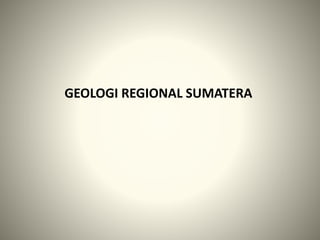Geologi Sumatera.pptx
- 4. Tipe Pembentukan Gunung Convergent Boundaries : (a) oceanic vs continent, (b) oceanic vs oceanic, (c) continent vs continent Press and Siever (1998)
- 5. Convergent Boundaries : (a) oceanic vs continent (Subduction), (b) continent vs continent (collision) Press and Siever (1998)
- 9. Katili(1973) Present Plate Boundaries in South East Asia
- 10. Indonesia Tectonic Boundary âĒ West : Great Sumatra and Mentawai duplex mega-shears, Sumatra Trench âĒ South : Java Trench-Timor-AruTrough âĒ East : ArafuraPlatform (Australia Craton) âĒ North : SorongFault, North SulawesiTrench, SCS (South China Sea) Plate Tectonics Movement In Indonesia Involves : âĒ Convergence, (collisions, subductionand obduction) âĒ Divergence (rifting, break-up and subsequent seafloor spreading) âĒ Transvergence(wrench faulting) involving translation and rotation Plate tectonics subdivision of indonesia âĒ West Indonesia with Sunda Platform acting as a continental core âĒ Central Indonesia consising of fragmented microcontinents represented by Sulawesi and the Banda Arc âĒ East Indonesia with the Arafura Platfrom acting as a continental core
- 11. Tectonic Framework of Indonesia
- 13. Sukamto(2000)
- 14. Sukamto(2000)
- 21. SUMATRA MAJOR TECTONIC ELEMENTS âĒ The SundaShelf borders the back arc basin to the east âĒ AsahanArch, BukitTigapuluhMountains and LampungHigh partitions the back-arc basins âĒ The BukitBarisanRange : NeogeneMagmaticarc, separates the back-arc basins from West Sumatra fore-arc basins âĒ The Outer Arc Islands : accretion wedges âĒ The Sumatra trench: an oblique subductionzone
- 22. Sumatra Pre-Tertiary Basement âĒ Pre Tertiary rocks are exposed in the BarisanRange, TigapuluhMountains and LampungHigh. âĒ Sumatra Pre-Tertiary rocks have been analyzed into separate terranesconsisting of :âhighly tectonizedPaleozoic and Mesozoic terranesâPaleozoic to Mesozoic intrusive rocksâ Melange(ophioliticrocks). âĒ Pre-Tertiary terranesare interpreted as a collage of Asian and Gondwananmicrocontinents.
- 24. SUMATRA TERTIARY BASINS âĒ Back-arc and partly fore-arc basins are underlain by continental crust. âĒ The magmaticarc, BarisanRange, uplifted Pre-Tertiary rocks forms border to the basins. âĒ Paleogenerift basins extend from back-arc to fore-arc basins across the BukitBarisan. âĒ Volcanism is limited to Paleogene(in the Southwest) and Plio- Pleistocene. âĒ The presence of the Great Trans-Sumatra wrench fault (SemangkoFault) along the BukitBarisan.
- 28. Sumatra Tectono-Stratigraphic System From top to base : âĒ Syn-orogenicdeposition in a back-arc basin : regressive (Mid-Miocene-Recent)ârising BarisanRange clasticsource âĒ Post-rift deposition in a shelfalbasin : transgressive(Early Miocene) âSundalandclastics source and carbonates âĒ Syn-rift deposition in active rift-valley basins : one or more rift phases (?Eocene-Oligocene)âlocal clasticsource
- 29. Sumatra Major Fault System THE TRANS SUMATRA STRIKE-SLIP FAULT SYSTEM : active since Early Tertiary times âĒ THE PALEOGENE BASEMENT FAULT SYSTEM : ïķThis fault system resulted in the Paleogenegraben-half- grabensystem with syn-rift deposition ïķThe Sumatra PaleogeneFault System extends SE to the NW Java basinalarea
- 31. The PaleogeneBasement Fault System âĒ This fault system consists of two main componentsâN-S componentâWNW-ESE componentâIn South Sumatra a NE- SW component is present âĒ This fault system cuts clear across the BarisanRange, beneath the fore-arc basin. âĒ This fault system is responsible for the development of Paleogenegraben-half-grabenbasin system with syn-rift deposition forming important oil kitchens.
- 34. PaleogeneBasement Faults Explanation âĒ Moulds (1989): Faults are mainly N-S and was created due to the E-W directed extensional regime during the initial stage of the N- S directed stress caused by the subduction. âĒ Other explanation: transtensionalfaults due to the dextral wrenching movements of the Indian Ocean Plate relative to the Sundacontinental plate
- 35. TERIMA KASIH



































